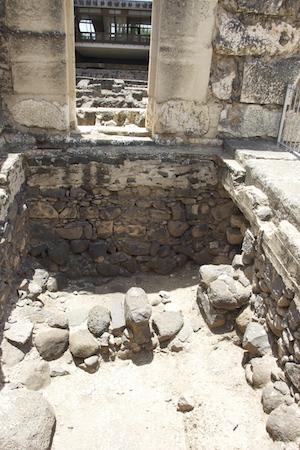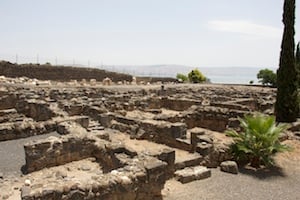Capernaum
Several times in the Gospels, Capernaum is named as Jesus’ home during his public ministry. After his birth in Bethlehem and exile in Egypt, he grew up in Nazareth, but Capernaum seems to have been where he was based once he began his ministry (Mk 2:1).
When Jesus made his appearance in Nazareth, the Gospels describe him “returning” and note that people there had heard about the signs he had worked in Capernaum (Lk 4:16, 23). He may have been a familiar face in Capernaum for a time in his young adulthood—the Gospels say that when he goes to Capernaum, Jesus comes “to his own home” (Mt 9:1), signifying intentionality around adopting it for a time. He may have lived and worked with some of the disciples, so that they were ready to respond to him when he called them to follow him.
Capernaum is situated on the northwest shore of the Sea of Galilee (see its location with this map). The name Capernaum is a combination of non-Semitic words: k’far, meaning “village,” and Nahum, which is a proper name. To people at the time of Jesus, the town was essentially known as “Village of Nahum”—in the same way we know some U.S. cities as Allentown or Jacksonville.
The town sits at the crossroads of a much-traveled trading route named the Via Maris (“way of the sea”) that connected Egypt to Damascus along the Mediterranean coast. It was also a border town of sorts, situated between different territories. Tax and trade were important here, which explains why it held a customs office (where Matthew was called in Mt 9:9) and a military outpost under the leadership of a centurion (Mt 8, Lk 7).
There is no obvious reason why Jesus chose to live in Capernaum. He probably landed there it because it was the home of his first followers, Peter and Andrew, as well as James and John (Mk 1:29). It is certain that he visited Peter’s home there (pictured here, more below), and possible that he lived with Peter there, or stayed with him for an extended time.
We know Peter was married—the Gospels mention his mother-in-law (Mt 8:14-15; Lk 4:38-39). He was from Bethsaida, and though it was customary for a man to bring his wife into his own family’s household, Peter joined his wife’s home in Capernaum. Her family must have needed help—it is possible that his father-in-law was injured or killed in an accident. Perhaps Peter took up fishing to carry on the business of his wife’s family.
The town held a synagogue, but the people were not wealthy enough to construct it themselves—it was built by the centurion stationed there (Lk 7:4-5). Today, visitors can see the foundations of the synagogue in which Jesus taught and healed—pictured here. He spoke of himself as the Bread of Life in this synagogue (Jn 6:59). The Gospels record several healings and confrontations that happened there—these events angered the Pharisees, and they began to hatch a plot to kill him.
The stone around Capernaum is black basalt, a volcanic, porous rock that is not easily shaped and not very strong. The homes at the time of Jesus were all one-story buildings—essentially walls without windows that held light roofs of thatch and mud. Think of the paralytic who was lowered down by his friends in Mk 2:1-12—the roof sections would have been easy to remove. The rock was also used as cobblestones for streets and floors inside homes—the rough, irregular shapes of the rocks would have made it easy for a dropped coin to be lost in the cracks (Lk 15:8).
The village would have extended only about 300 yards along the shoreline—it was not a big village, and one can easily imagine everyone knowing when Jesus was present (Mk 2: 1). Anything he did would have been the talk of the entire town.
Pilgrims can visit Peter’s house in Capernaum—excavations of a fourth-century church reveal that it was built around a room that had been singled out and preserved. The walls of that room are filled with graffiti, some of which name Jesus as Lord and Christ. In addition, archeologists found evidence that the space was used as a public gathering place. These findings agree with ancient texts from pilgrims who identify the location as Peter’s house, where Jesus stayed.
In 1990, a modern worship space was built over Peter’s house. The church is octagonal and has an open, glass floor above the ruins so that you can see them from inside—it is visible in the video below.
The Sea of Galilee dominates the landscape in Capernaum. Fishing is a major industry, which may explain why fish play a large role in Jesus’ parables and stories. Jesus walked on water near here, and calmed the storm in this part of the lake.
Scriptural Passages Associated with Capernaum
- LK 4:38-44 (Jesus heals Peter’s mother-in-law.)
- LK 4:31-37 (Jesus heals a demoniac.)
- LK 7:1-10 (Jesus heals the centurion’s slave from a distance.)
- Mk 1:21-28 (Jesus heals a demoniac in the synagogue.)
- Mk 1:29-39 (Jesus heals Peter’s mother-in-law.)
- Mk 2:1-12 (Jesus heals a paralytic lowered through the roof.)





